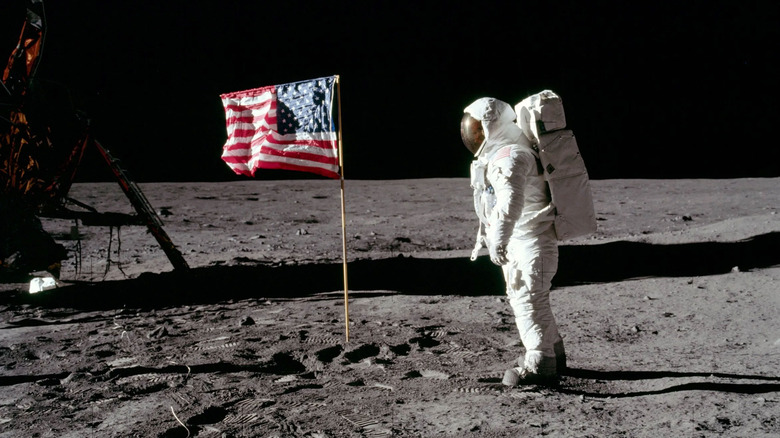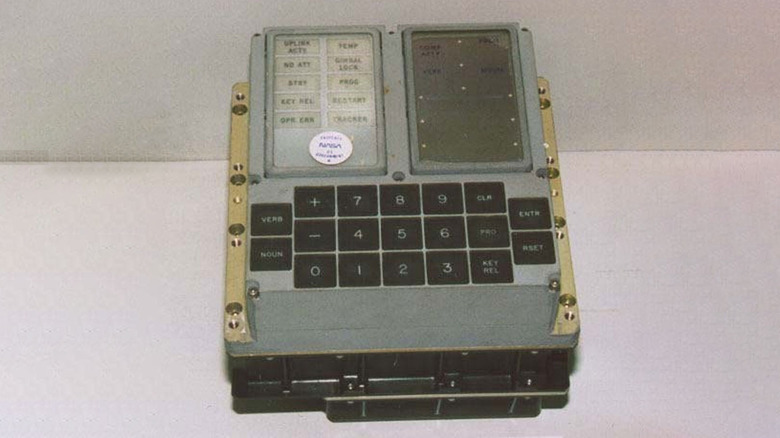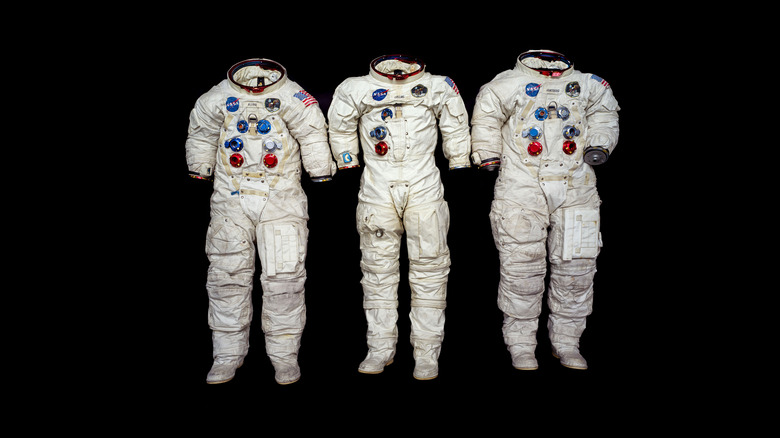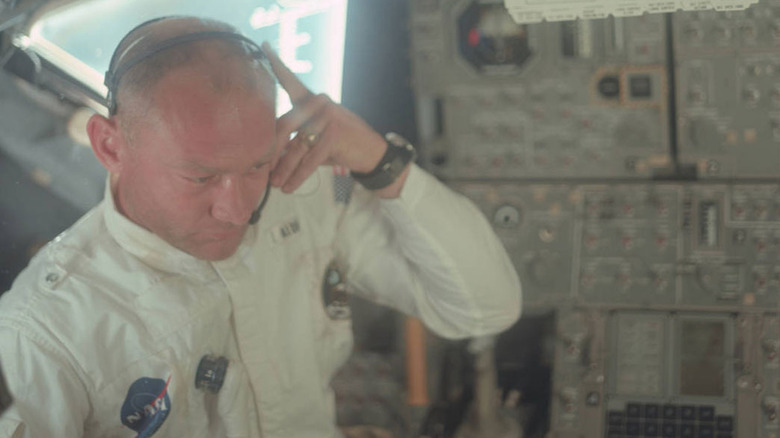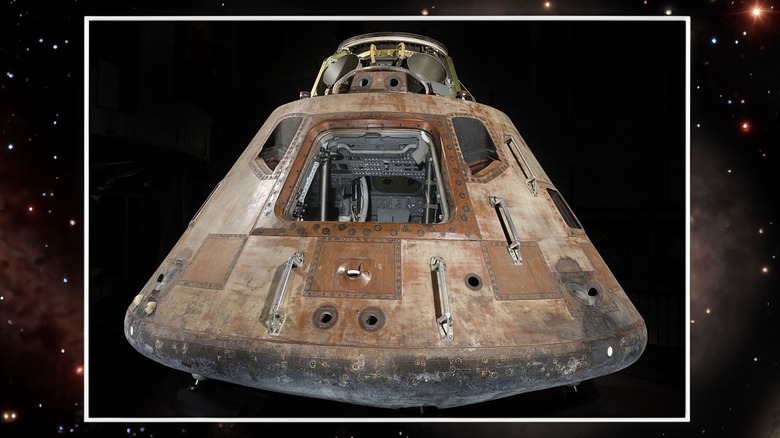Giant Leap: The Technology That Made The Apollo Mission Successful
While you probably already know about the Apollo 11 moon landing, you may be surprised to learn that NASA's Apollo Program ran from 1962 to 1972 and included 14 total missions, six of which were lunar landing missions. The first Apollo 1 mission, which took place on January 27, 1967, and was originally named Apollo-Saturn 204 (AS-204), sadly ended in a tragedy when the three astronauts on board — Virgil Grissom, Edward White, and Roger Chaffee perished in a fire onboard the craft.
Later that same year, on November 9, 1967, NASA worked to fix issues aboard the rocket; with the subsequent mission, Apollo 4 (there was never an Apollo 2 or 3 mission), marking the first flight of a crewless Saturn V launch vehicle. Less than two years later, on July 20, 1969, the Saturn V took Neil Armstrong, Michael Collins, and Edwin "Buzz" Aldrin on board the Apollo 11 spacecraft into space to eventually land on the Moon.
Though an amazing accomplishment in such a short period (especially for the limited technology of the '60s), it required a suite of brand-new technology, the likes of which the world had never seen before. This perfect confluence of cutting-edge tech mixed with techniques learned over hundreds of years enabled the Apollo astronauts to pull off what was considered previously impossible. These early innovations would later inspire a host of modern technologies in electronic devices we use daily.
The Apollo Guidance Computer: one of the first onboard control computers
The Apollo Guidance Computer would go on to inspire the technology fitted to most modern aircraft today. Rather than relying on mechanical elements like hydraulics and cranks, the 74KB ROM & 4KB RAM computer was a game-changing innovation that enabled the controlled guidance and navigation of the spacecraft. While it was incredibly weak to today's standards, the invention proved computers could be installed and used in aircraft and other vehicles.
To illustrate how innovative and cutting-edge this was, the BBC reports in the 1960s, the Apollo Program consumed 60% of all integrated circuits produced in the U.S. The program would also reach 4% of the federal budget, with tens of thousands of companies and universities contributing to research and development.
Today, the influence of the earliest computers onboard the Apollo is reflected in the most sophisticated aviation software onboard cutting-edge aircraft like the F-35 and the smartphones we use every day.
Apollo spacesuits used three decades of textile technology
Though the iconic white NASA spacesuits used during the Apollo 11 moon landing may be well-known across the world, the technology that went into producing them is still quite impressive to this day. Using various materials and fabrics, including neoprene synthetic rubber, nylon, Teflon, Lycra spandex, and Nomex, 12 synthetic materials were used to create the 25-layer suit.
Capable of protecting astronauts in temperatures of up to 230 degrees Fahrenheit and down to negative 250 degrees Fahrenheit, this new technology protected astronauts as they made their first journey across the Moon's surface. Unlike the Gemini and Mercury spacesuits that came before it, the Apollo spacesuits also had the first wireless life support systems and special boots to walk across the rocky terrain.
Each space suit was specifically designed for the astronaut and created an airtight seal via a three-layer zipper made of two layers of brass with a layer of rubber in between. When pressurized, the rubber expanded, creating an airtight seal. Neil Armostrong's Apollo 11 spacesuit was named Sirius, after the brightest star system in Earth's sky.
General Dynamics S-Band Transponder tracked Apollo 11
Part of the Apollo 11 mission technology included the S-Band Transponder designed by General Dynamics that broadcasted Neil Armstrong uttering the iconically misspoken line, "That's one small step for man, one giant leap for mankind." During the moon landing mission, this communication performed a multitude of functions other than just relaying communications, including tracking the command module or the astronauts' living quarters.
Development for the Transponder began in 1962, and the new system tracked the Apollo spacecraft and transmitted and received telemetry signals and flight data between ground stations scattered worldwide and the Apollo 11 spaceship. Once reaching 30,000 miles from Earth, it was the only way the astronauts could stay connected. In addition, the transponder provided video and voice communications, mission data, distance, and biomedical information on Armstrong, Collins, and Aldrin.
Today, General Dynamics is developing transponders to communicate with ships further out in space, including missions to Mars and for the upcoming Orion spacecraft under development by NASA.
The Apollo Saturn V rocket was taller than the Statue of Liberty
Measuring 363 feet in height, the Saturn V rocket was 60 feet taller than the Statue of Liberty and weighed a total of 6.2 million pounds, making it the largest rocket the world had ever seen up until this point. This rocket would be used in various missions, starting with the Apollo 4 mission and ending when the last mission utilizing the Saturn V blasted off in 1973, which carried the Skylab space station into Earth's orbit.
The five-engine, two-stage rocket launched with 7.6 million pounds of thrust and can lift a payload weighing as much as 130 tons into Earth's orbit. Prior to the Saturn V, the Saturn IB, an eight-engine rocket, was capable of producing only 1.64 million pounds of thrust at liftoff.
Today's heavy lift system, what NASA calls its Space Launch System (SLS), will be capable of providing 9.5 million pounds of launch thrust in its Block 2 version, which is meant to be able to propel ships further out into space. NASA plans to send astronauts back to the Moon in 2024 as part of the Artemis Program.
Apollo living quarters or command module inspires designs today
The Apollo 11 command module, or living quarters for the astronauts on the Apollo missions, was originally derived from designs from the Apollo 9 missions, where the command module was called Gumdrop. For Apollo 11, the command module, named Columbia, served as the living quarters for the three-person crew and was manufactured by North American Rockwell.
The Columbia measured only 3.9 meters in diameter and was 3.65 meters tall. It was an aluminum honeycomb sandwich bonded between sheets of aluminum alloy. Using a heat shield created with brazed stainless steel honeycomb filled with phenolic epoxy resin, it was the only part of the Apollo 11 ship that would re-enter Earth's atmosphere. People can take a 3D tour of the cramped space on the Smithsonian website.
Today's modern rocket, the Orion spacecraft from NASA, utilizes the Lockheed Martin crew module and can sustain astronauts for up to 21 days before docking onto another spacecraft. Though it's been over 50 years and leaps and bounds in technological advancement, it looks similar, at least in design, to the module used back on the Apollo 11 mission.
